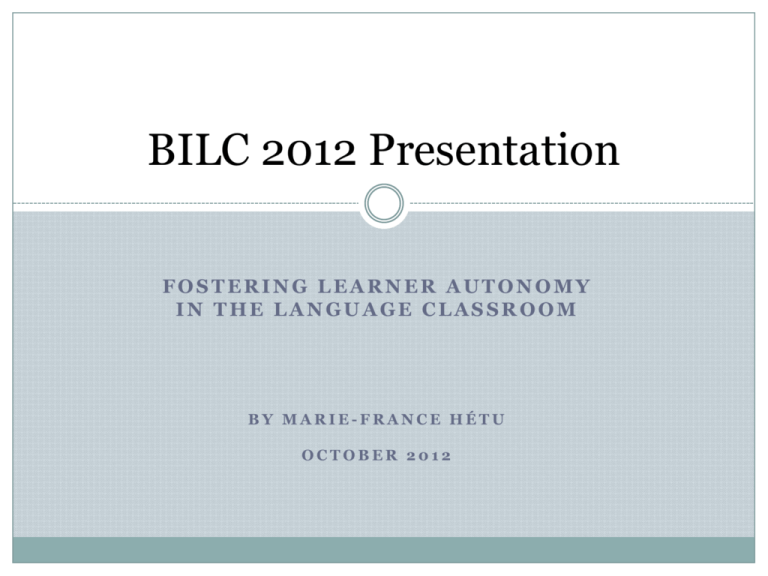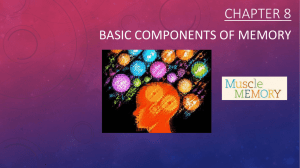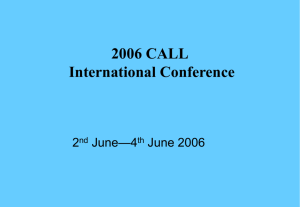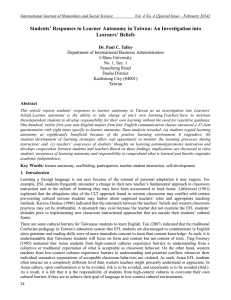My Personal Philosophy By: Marie
advertisement

BILC 2012 Presentation FOSTERING LEARNER AUTONOMY IN THE LANGUAGE CLASSROOM BY MARIE-FRANCE HÉTU OCTOBER 2012 CFLS in the Gatineau Hills Ideal Setting CFLS Mission Other Roles My Role as a Teacher CFLS also Provides Foreign Language (FL) Programs French and English FL Programs Military Training and Cooperation Program (MTCP) English and French Language Teacher Training Course (LTTC) Overview of Presentation Fostering Learner Autonomy Overview Teaching approaches and principles Importance of fostering learner autonomy Qualities and attributes of self-learners Fostering organization, metacognitive, critical thinking skills Authentic materials Web 2.0 tools, online programs and BYOD Teaching a Second Language at CFLS Andragogy Principles Communicative Principles Student-Centered Approach = Learner Autonomy Principles of Andragogy All Learning Begins with Experience – Adults . . . • Are Goal • Are SelfDirected Oriented • Are Internally Motivated Bring Life Experiences Bring Knowledge Need Respect Need a Purpose • Are Practical The Communicative Approach Uses the Target Language: As a Medium of Communication, With a Social Purpose Through Meaningful Activities. With Emphasis on the Message not the Form. To Provide Real-Life Communication Through Active Modes of Learning A Learner-Centered Approach Focuses on: Honing Learning Skills Developing Autonomy Fostering Active Learning Knowledge Building Learner Needs Supporting a Learner-Centered Approach Maximize Foster Provide • Learner Past Experiences • Reflective Learning Experiences • Active Participation • Group- and Pair-Work • Authentic Learning Opportunities • Learning Options Along Student Interests Student Autonomy Can Help a Learner • Develop Critical Thinking Skills • Build Metacognitive Skills Apply Course Learning Make Meaning of One’s Learning • Build on Knowledge • Connect and Integrate Language Concepts • Gain Insight and Share with Peers • Define Learning Attain Personal Growth Learners Can Be Encouraged to Further Develop Autonomous Skills, Such as: Self-Discipline Metacognitive Skills Curiosity Embodied Learning Goal Oriented Independence Reflective Skills Fostering Learner Autonomy in the Language Classroom Learner-Led Morning Warm-up Authentic and À Propos Elements Pedagogical Outings – Learners Are Responsible For: Online Self-Learning Allies Learners Choose Activities Listening Comprehension Activities Focus on Learners’ Work Environment Grammar Exercises Listening, Repeating, Recording Online Self-Learning Program My Account Just-In-Time Grammar Activities Are Self-Learning and Self-Paced Good Selection of Educational Games FSL Exam Preparation BYOD to the Classroom Electronic Devices as a Learning Tool Review of Apps Using Apps Appropriately Using Apps to Review Ongoing Learning BYOD and App Advantages Build on Learning Research Tool Learning Tool Sharing Tool Consolidate Information • Build Reflective Skills • Retrieve Information Develop • Build Critical Metacognitive Thinking Skills Skills BYOD Rules in Class Use Devices at Appropriate Time Limit Use Use at Appointed Time Verify Appropriateness of App Right Level of Learning Linked with Present Learning Investigate App Quality of Activities Possible Uses in Class Possibilities for the Language Classroom in the Future Integration of more Web 2.0 tools in the classroom to provide learners with autonomous ways to learn and practice their second language: Targeted social-networking sites Second-language blogs Messaging through text, voice and video Virtual second-language learning communities Thank you I look forward to answering your questions during the plenary session Special Thanks I would especially like to thank the following learners who graciously allowed me to film and take pictures during class time. WO Lee, WO Spence, WO Grant, Sgt Foster, OCdt Salnikov, Lt(N) Locke, MWO Krammer, Capt Mathews References Anderson, T. (2004). Toward a theory of online learning. In T. Anderson & F. Elloumi (Eds.) Theory and Practice of Online Learning, 33-59. Bates & Poole. (2003). A Framework for Selecting and Using Technology. Effective Teaching with Technology, (75-105). San Francisco: Jossey-Bass. Dall’Alba, G. & Barnacle, R. (2005). Embodied knowing in online environments. Educational Philosophy and Theory, 37(5), 719-744. https://www.vista.ubc.ca/webct/urw/lc5116011.tp0/cobaltMainFrame.dowebct Downes, S. (2004). Educational blogging. Educause Review, 39(5), 14-26. http://www.educause.edu/ir/library/pdf/erm0450.pdf Heckman, R., & Annabi, H. (2006). Cultivating voluntary online learning communities in blended environments [Electronic Version]. Journal of Asynchronous Learning Networks, 10(4), 51-66. Lipman, M. 1991. Thinking in education. Cambridge: Cambridge University Press. Scardamalia, M., & Bereiter, C. (1994). Computer support for knowledge-building communities. The Journal of the Learning Sciences, 3(3), 265-283. Shea, P., & Bidjerano, T. (2009) Community of inquiry as a theoretical framework to foster ‘‘epistemic engagement” and ‘‘cognitive presence” in online education. Computers & Education, 52, 543-563. Swan, K., & Shea, P. (2005). Social presence and the development of virtual learning communities. In S. Hiltz & R. Goldman (Eds.), Learning together online: Research on asynchronous learning networks (pp. 239–260). Mahwah, NJ: Lawrence Erlbaum. Utecht, J. (2007). Blogs aren't the enemy. Technology & Learning, April (9) 32-3 Photo Credits Screen Captures: http://www.allies.forces.gc.ca/ http://www.csps-efpc.gc.ca/myaccount/indexeng.aspx Photography and Videography: Marie-France Hétu With the special collaboration of: WO Lee, WO Spence, WO Grant, Sgt Foster, OCdt Salnikov, Lt(N) Locke, MWO Krammer, Capt Mathews









